Ecological Research Cover Gallery
写真をクリックするとその年初号のIssue Information (Free access) が開きます。Cover captionは、2ページ目下部に表示されています。
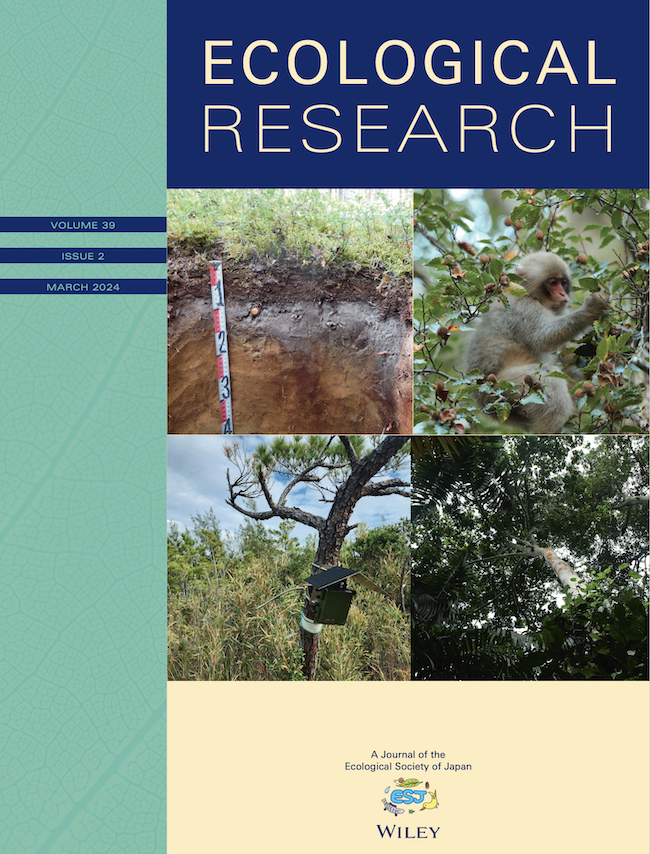
2024_Vol.39
- Top left: Podzol developed under Scots pine forest in Estonia. Photo by Kazumichi Fujii.
- Top right: A juvenile Japanese macaque (Macaca fuscata) eating nuts of Japanese beech (Fagus crenata). Photo by Yamato Tsuji.
- Bottom left: Acoustic recording unit for monitoring species and soundscapes in Okinawa. Photo by Samuel R.P-J. Ross.
- Bottom right: Canopy of lowland tropical forest on Barro Colorado Island, Panama. Photo by Ryosuke Nakamura.
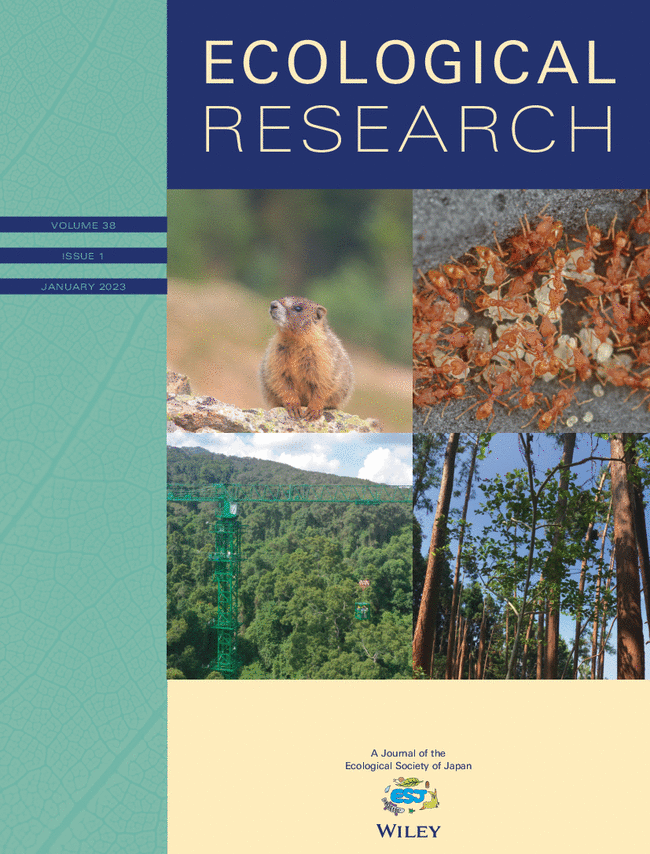
2023_Vol.38
- Top left: The yellow-bellied marmot Marmota flaviventer in Rocky mountain, Colorado, USA. Photo by Kenta Uchida.
- Top right: A lab colony of Strumigenys rogeri with brood, notable for its ultrafast “trap-jaw” mandibles. Photo by Gaurav Agavekar.
- Bottom left: Canopy crane (80 m high, 60 m jib length) in a monsoonal tropical forest of southwestern China. Photo by Peng Zhang (Xishuangbanna Tropical Botanical Garden).
- Bottom right: A Japanese cedar plantation in the Boso Peninsula hit by Typhoon Faxai in 2019. Photo by Maki Suzuki.
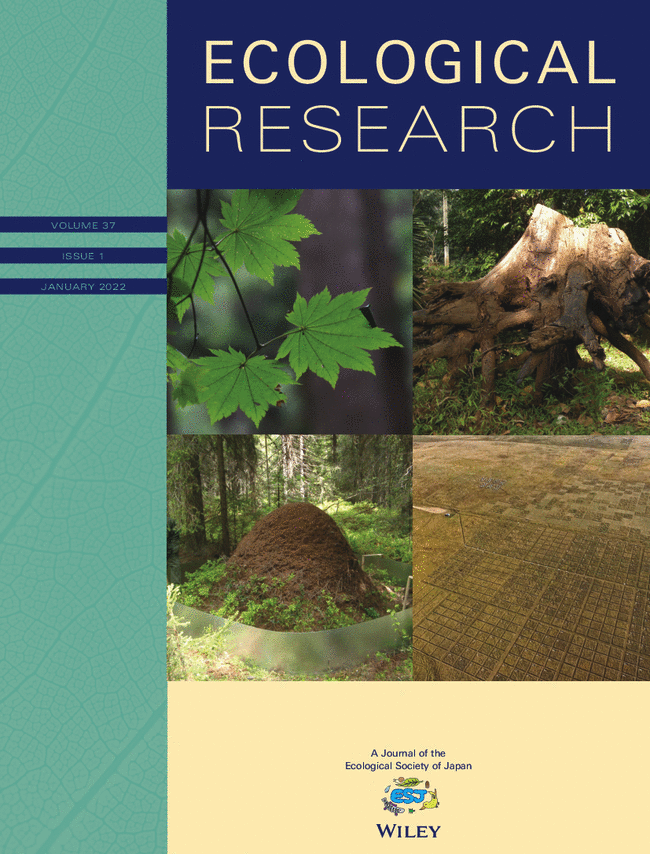
2022_Vol.37
- Top left: Leaf cone moths (Caloptilia) feeding on maples (Acer). Photo by Ryosuke Nakadai.
- Top right: Coarse root system of a tropical tree in Malaysia. Photo by Mizue Ohashi.
- Bottom left: Formica ant mound in a Finnish boreal forest. Photo by Mizue Ohashi.
- Bottom right: The Inner Mongolia Grassland Removal Experiment (IMGRE). Provided by Takehiro Sasaki (photo courtesy of Yusuke Takagi).
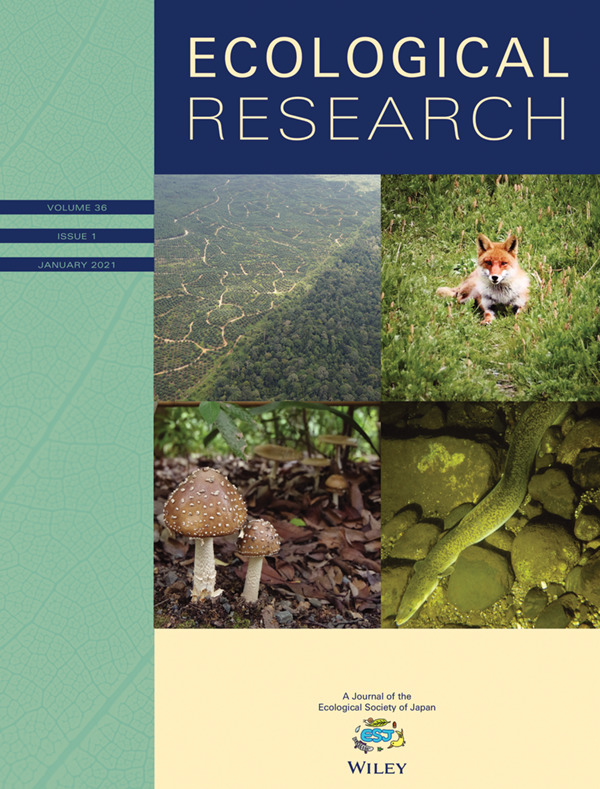
2021_Vol.36
- Top left: Expansion of oil palm plantation to mixed dipterocarp forest in Sabah, Malaysian Borneo. Photo by Nobuo Imai.
- Top right: Japanese red fox in Fukui Prefecture. Provided by Masumi Hisano (photo courtesy of Shota Deguchi).
- Bottom left: Ectomycorrhizal fungi (including Amanita sp.) mediate plant-soil feedback to affect tree community assembly. Photo by Komei Kadowaki.
- Bottom right: Indo-Pacific eel being active at night in the Isso River, Yakushima Island. Photo by Kentaro Morita.
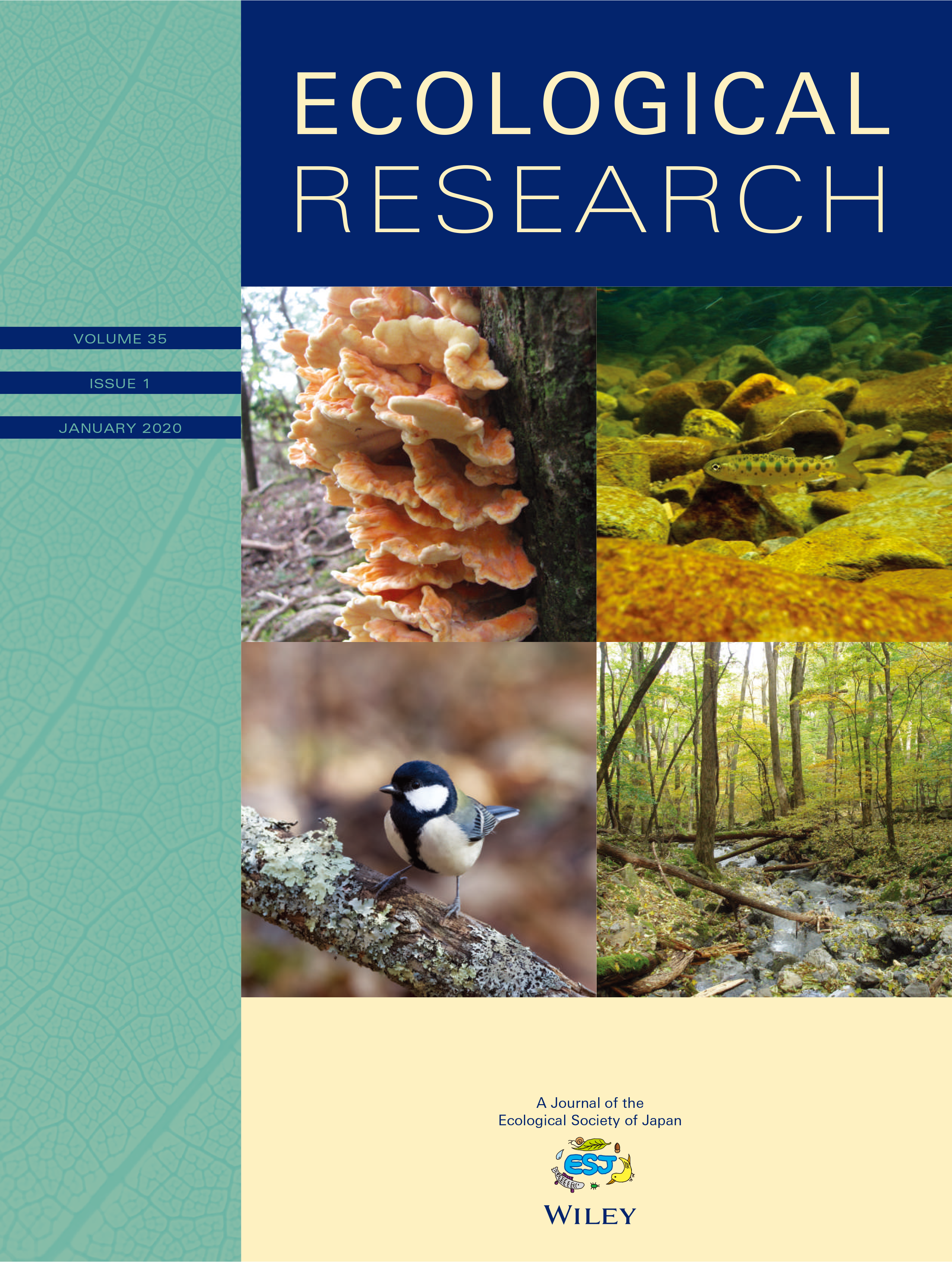
2020_Vol.35
- Top left: Laetiporus sulphureus fruiting on a standing tree stem at Odaigahara, Kii peninsula, Japan. Photo by Yu Fukasawa.
- Top right: Juvenile Masu salmon in the Shubuto River basin, Hokkaido, Japan. Photo by Akira Terui.
- Bottom left: Japanese tits combine calls to form complex messages, providing the evidence for syntax in animals. Photo by Toshitaka N. Suzuki.
- Bottom right: Riparian forest (Fraxinus platypoda) in Chichibu Mountains, Japan. Provided by Hitoshi Sakio.
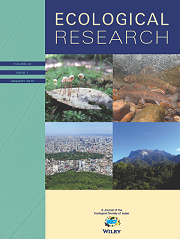
2019_Vol.34
- Top left: Gymnopus sp. causing bleaching of leaf litter at Hachijo Island, Tokyo, Japan. Provided by Takashi Osono.
- Top right: Partially migratory Dolly Varden charr (Top, resident; Bottom, potential migrant). Provided by Genki Sahashi.
- Bottom left: Fragmented urban forests in Tokyo, Japan. Provided by PIXTA.
- Mt. Kinabalu in Borneo, Malaysia viewed from Park Headquarter of Kinabalu Park. Provided by Masayuki Ushio.
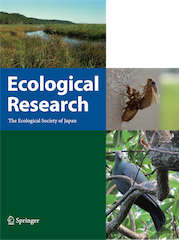
2018_Vol.33
- In mires, the most important division is between fen dominated by large sedges and grasses and bog dominated by sphagna with dwarf sedges and shrubs. The hydrochemical distinction between fen and bog is characterized by soil–water pH, which is closely related to the decline of organic nitrogen availability in low-pH bog. The photo (top) is of a fen in Lake Yudonuma, taken by Takatoshi Nakamura.
- Periodical cicadas (Magicicada spp.) in the USA are well known for their nearly perfectly synchronized mass emergences of millions per acre with 13- or 17-year prime-numbered life cycles. The photo (middle) is of a 13-year cicada emerging on the wall of house in 2011, taken by Hiromu Ito.
- Endemic subspecies of the Japanese wood pigeon Columba janthina nitens in the Ogasawara Islands, called the red-headed wood pigeon (bottom). The pigeons move widely among the islands, perhaps due to a lack of food resources in a single island habitat. They choose lipid-rich fruits but flexibly change their diet and sometimes depend on introduced plants. Photo by Haruko Ando.
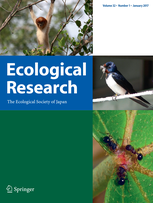
2017_Vol.32
- Proboscis monkeys are foregut-fer-menting primates, having the first rumination behavior observed in free-ranging primates. They ingest a diet consisting of various proportions of leaves and fruit and are endemic to Borneo, inhabiting mangroves, swamps, and riverine forests. The photo (top) is of an infant in the lower Kinabatangan, Sabah, Malaysia, by Ikki Matsuda.
- A male barn swallow, Hirundo rustica, collecting mud to repair an old nest in his territory. Quality and quantity of old nests in the territory is a major female mate choice criterion, together with secondary sexual characteristics and nestling-like vocalization, in the barn swallow (middle). Photo by Masaru Hasegawa. *Masaru Hasegawa is the recipient of the 4th Suzuki Award!!
- The Japanese mallotus, Mallotus japonicus, attracts many ants because the plant provides food substances such as extrafl oral nectar and lipid-rich particles on its leaves. In return, the ants protect the plant from herbivores. The photo (bottom) shows nectar-sucking ants, Pristomyrmex punctatus, on large extrafl oral nectaries located at the leaf base. Photo by Akira Yamawo.
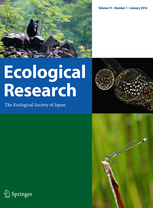
2016_Vol.31
- Asiatic black bears (Ursus thibetanus) are distributed in broad-leaved forests in East and West Asia. As megafauna and frugivores, they have an important ecological function as seed dispersers that help to maintain forest ecosystems. The photo (top) is of a young bear yawning atop a rock in the Ashio-Nikko mountains. Photo by Hiroshi Yokota.
- Rotifer (Brachionus calyciflorus) populations are used to study predator?prey dynamics with green algae (Chlorella or Chlamydomonas) in microcosm experiments (middle). Changes of predation pressure cause rapid evolution of algal defense traits, resulting in long cycles with a half-period phase-lag between predator and prey densities. Photo by Minoru Kasada.
- A male of the common blue-tail damselfly (Ischnura senegalensis) (bottom). While males are monomorphic, females exhibit a heritable color polymorphism, consisting of ancestral morphs (gynomorphs) and male-like morphs (andromorphs), maintained under negative frequency-dependent selection derived from positive frequency-dependent male harassment. Photo by Yuma Takahashi*.
- *Yuma Takahashi is the recipient of the 19th Miyadi Award!!
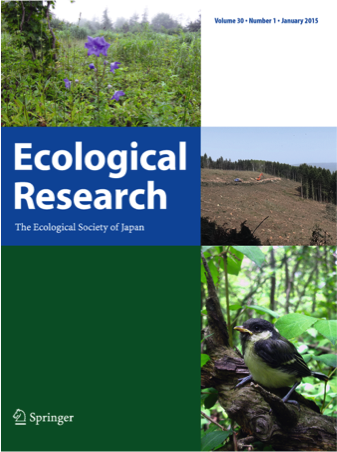
2015_Vol.30
- Semi-natural grasslands have been an important land-use and ecosystem in Japan, but their areas are now rapidly declining due to the fuel and fertilizer revolution. However, we can find the remnants of the grasslands in some places such as the Hayasaka Plateau, Iwate Prefecture (top). Forestry practices are expected to restore early-successional habitats including semi-natural grasslands. In central Hokkaido, a large-scale experiment of alternative harvesting methods (Retention Experiment for plantation FoREstry in Sorachi, Hokkaido: REFRESH) has just started (middle). Photos by Yuichi Yamaura*
- Japanese tit (Parus minor) parents produce diff erent alarm calls for diff erent nest predators. Nestlings keep crouching inside their nest cavity when hearing alarm calls for crows, whereas they jump out of the cavity when hearing alarm calls for snakes (bottom). The two responses help the nestlings to evade crows’ beaks and snake invasion, respectively. Photo by Toshitaka Suzuki**
-
*Yuichi Yamaura is the recipient of the 18th Miyadi Award!!
Check his award article -
**Toshitaka Suzuki is the recipient of the 2nd Suzuki Award!!
Check his award article
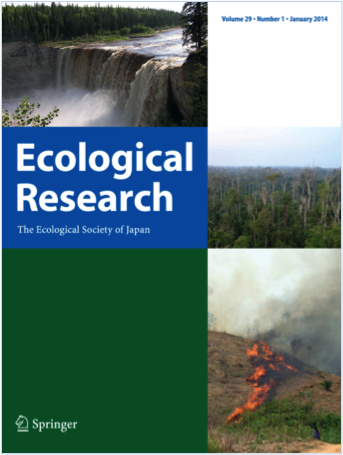
2014_Vol.29
- Water drives nutrient cycles within or between ecosystems. Dissolved organic matter plays important roles in transport of nutrients in northern ecosystems. Black river water rich in dissolved organic matter can be produced from organic soils in the Northwest Territories, Canada (top). Substantial production of dissolved organic matter in the organic layer can enhance mobilization of nutrients from the highly leached soil without increasing leaching risks under tropical forest in East Kalimantan, Indonesia. Forest damages by fires and logging could disrupt this cycle and increase nitrate leaching (middle). Conversion of slash-burn agriculture to continuous cropping can also increase nitrate leaching and soil acidifi cation, as in northern Thailand (bottom). Photos by Kazumichi Fujii*
-
*Kazumichi Fujii is the recipient of the 1th Suzuki Award!!
Check his award article
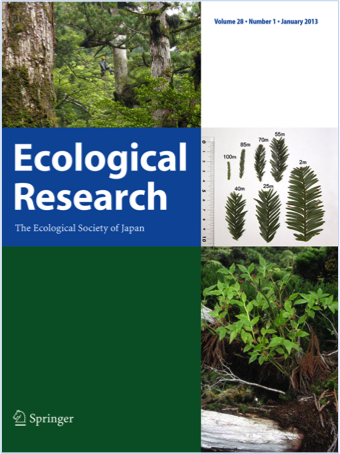
2013_Vol.28
- Because of their overwhelming size over other organisms, trees define the structural and energetic properties of forest ecosystems. With the development of safe, reliable tree-climbing techniques, ecologists can now explore the canopy of many forests to quantify its structure and function. Ecosystem productivity tends to be higher in vertically welldeveloped forests, such as the mixed forests of Yakushima Island, Japan (top), where conifers and broadleaved trees are vertically stratified. Because trees have evolved retaining high phenotypic plasticity, vertical variation in photosynthesis-related traits allows tall trees such as Sequoia sempervirens in northern California, USA (middle), to fully exploit the highly variable light environment of the forest canopy. The forest canopy also harbors diverse and unique organisms, such as the epiphytic plant Vaccinium yakushimense (bottom), which is endemic to Yakushima Island and grows almost exclusively on old-growth Cryptomeria japonica trees. The photo shows the plant growing on a dead branch. Photos by Hiroaki Ishii*
-
*Hiroaki Ishii is the recipient of the 5th Oshima Award!!
Check his award article
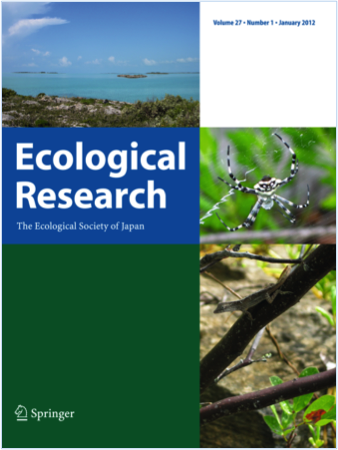
2012_Vol.27
- Ecosystem size may be an important factor determining food-chain length. Ecologists have long struggled to understand the causes of variation in foodchain length. The Bahamian Islands (top) in the Atlantic Ocean have many small and large islands along a variety of environmental gradients, offering great opportunities to study the environmental variables that drive variation in food-chain length among islands. Top predators on the islands are orb spiders, such as Argiope argentata (middle), and lizards (Anolis sagrei; bottom). Their trophic position, estimated by stable isotope technique, showed significant increases with island area, being among the first examples from terrestrial systems that food-chain length increases with ecosystem size. Photos by *Gaku Takimoto
-
*Gaku Takimoto is the recipient of the 15th Miyadi Award!!
Check his award article
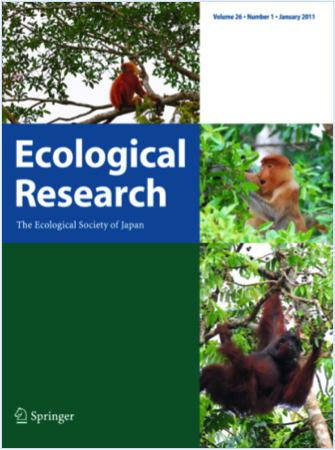
2011_Vol.26
- On Borneo Island, the expansion of oil palm plantations has destroyed large areas of rain forest. Although many wildlife species can still be observed in the Kinabatangan River conservation area, such protected areas are shrinking and becoming fragmented.
- Top: Red leaf monkey (Presbytis rubicunda).
- Middle: Male proboscis monkey (Nasalis larvatus).
- Bottom: Male orangutan (Pongo pygmaeus).
- Photos by Hajime Yoshino
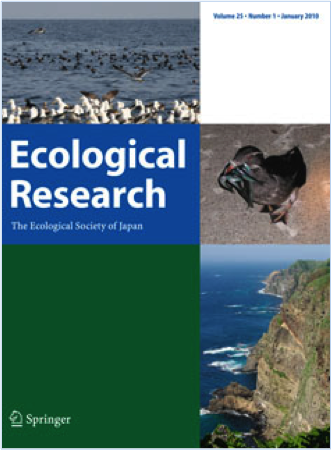
2010_Vol.25
- Teuri Island, in the Japan Sea, 30 km off the coast of nothern Hokkaido, and the surrounding waters support the largest colony (ca. 300,000 pairs) of rhinoceros auklets (Cerorhinca monocerata) in the world.
- Top: Rhinoceros auklets (background) and two species of gulls (black-tailed, Larus crassirostris, and slaty-backed, L. schistisagus) (foreground) in the water where they feed on sand lance (Ammodytes personatus). Photo by Yasuaki Niizuma
- Middle: A rhinoceros auklet parent returning to the island in the evening to feed its chicks with sea greenling (Pleurogrammus azonus). Photo by Yutaka Watanuki*
- Bottom: Cliffs where seabirds breed. Photo by Akinori Takahashi
- *Yutaka Watanukiis the recipient of the 2th Oshima Award!!